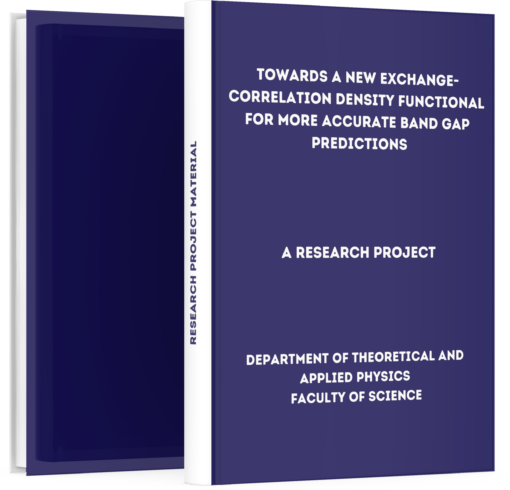Towards A New Exchange-Correlation Density Functional for More Accurate Band Gap Predictions
₦3,000.00
If you are interested in getting this project material “Towards A New Exchange-Correlation Density Functional for More Accurate Band Gap Predictions”, click on the DOWNLOAD BUTTON to make payment and the file will be delivered to your email immediately after confirmation.
Description
Download Towards A New Exchange-Correlation Density Functional for More Accurate Band Gap Predictions. Theoretical and applied physics students who are writing their projects can get this material to aid their research work.
Abstract
Density-Functional Theory (DFT) offers a simplification to electronic structure prob- lems by using the electron density instead of the wave-function.
Unlike the wave- function which is a function of 3N variables (excluding spin) for an N -electron system, the density depends only on three variables, irrespective of the number of electrons in the system.
While DFT, in principle, gives an accurate description of ground-state properties, practical applications of DFT are based on approximations to the so-called exchange-correlation (xc) potential.
The exchange-correlation po- tential describes the effects of the Pauli exclusion principle and the electron-electron Coulomb repulsion beyond a purely electrostatic interaction of the electrons.
A common description of exchange-correlation functional is the so-called local den- sity approximation (LDA) which locally substitutes the exchange-correlation energy density of an inhomogeneous system by that of an electron gas evaluated at that local density.
Introduction
Density-Functional Theory (DFT) is one of the most popular and successful Quan- tum Mechanics (QM) approach for large systems.
It is a widely used methods for “ab initio” calculations of the structure of atoms, molecules, crystals, surfaces and their interactions.
It is nowadays routinely applied for calculating e.g., the binding energy of molecules in chemistry and the band structure of solids in physics.
First application relevant for fields traditionally considered more distant from quantum mechanics, such as biology and mineralogy are beginning to appear.
Superconduc- tivity, atoms in the focus of strong laser pulses, relativistic effects in heavy elements and in atomic nuclei, classical liquids, and magnetic properties of alloys have been studied with DFT.
How to Download this Project Material
First, note that we are one of the best and most reliable online platforms because we don’t retain any of your personal information or data as regards making payments online.
PRICE: ₦3,500 ₦3,000 (Three Thousand Naira Only)
Make a bank deposit or mobile transfer of ₦2,000 only to the account given below;
Bank Name: UBA Account Number: 1022564031 Account Name: TMLT PRO SERVICES
After making the payment, CLICK HERE to send the following on WhatsApp;
- Depositor’s Name or Screenshot of Payment
- Name of the Past Question
- Active Email Address
or Call Us On +2348082284439 Once your details have been received and your payment confirmed by us, you will receive the past question in your email or WhatsApp within 5 Minutes.
Guarantee of Getting the Material
We understand that due to the high rate of fraud, many people are afraid of making purchases online but be rest assured that PastExamQuestions will deliver your material after payment.
Once your details have been received and your payment confirmed by us, you will receive the past question in your email or WhatsApp.
Give us Feedback
Have we been able to satisfy you? How well do you think the material will be helpful after having gone through it? Does the price worth the material?
Let’s hear from you! We recommend that our customers give feedback at the end of every transaction to enable us to serve better. You can do this by clicking the review button on this page.
Where is the review button? >> Just scroll up to where you see reviews





Reviews
There are no reviews yet.